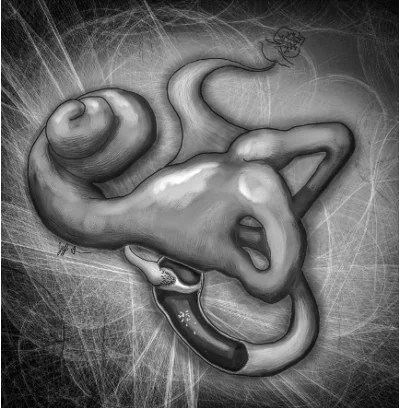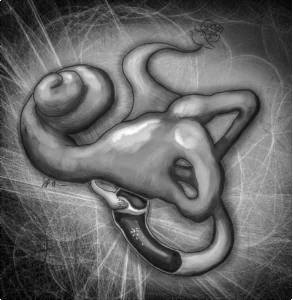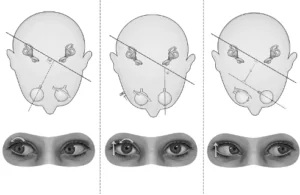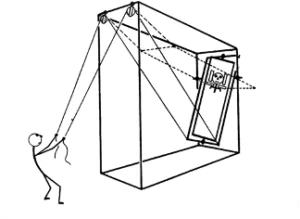
This article is adapted from The Great Balancing Act: An Insider’s Guide to the Human Vestibular System, published by Columbia University Press. Copyright (c) 2025 Jeffrey D. Sharon. Used by arrangement with the Publisher. All rights reserved.
It’s been said that half of medical school is necessary to learn the art of healing, and the other half is required to master the vocabulary. For me, it’s a love-hate relationship. Some of the terms seem to be overly long and complicated for no reason at all. For example, the general name for my field of medical expertise is “Otolaryngology” (which is synonymous with Ear, Nose, and Throat). The name is too long, too hard to pronounce, too hard to spell, and generally confusing for people. Furthermore, despite its length, the term isn’t accurate. “Oto” translates to “ear,” and “laryngo” translates to throat. That leaves out most of the disease areas under our umbrella, including the nose/sinus, face, neck, and mouth.
However, medical terminology can also reflect the storied history of humanity’s struggle to understand and heal itself. Names of body parts, diseases, and treatments often reflect the heroes (e.g., Prosper Ménière) and victims (e.g., Lou Gehrig) of that epic battle. They can also reflect mythology: cherubism causes cheeks to swell, resembling Renaissance depictions of the childlike cherubs. The uppermost vertebra is called the atlas, in homage to Atlas, the Titan of Greek lore who carried the weight of the world on his shoulders. Names can recall past culture: the Fregoli delusion, a belief that different people in your life are actually the same person in disguise, is named after a late nineteenth-century Italian actor, renowned for his ability to quickly change roles. As a surgical resident, I once cared for a patient diagnosed with “Ondine’s curse.” While we generally shy away from describing a disease as a curse, this one is so particularly vicious, perhaps the moniker is warranted. The poor souls with Ondine’s curse have a faulty drive to breathe. While awake, there are no issues. But breathing stops altogether once they fall asleep. Consider living a life where an afternoon nap could be fatal. As you would suspect, most do not survive their first night of life as a baby. But, with good fortune and astute physicians, some can survive, spending their time asleep connected to a mechanical breathing apparatus. In novels and plays based on old European folklore, Ondine is a spurned water sprite who cursed her former lover, causing his death when he forgot to breathe during a fateful kiss.
I would place Benign Paroxysmal Positional Vertigo (BPPV) in that first category. The name is unwieldy, causing many to refer to it as “loose crystals.” The title does make sense when broken down: benign (not an immediate threat to life), paroxysmal (occurring in fits or spurts), positional (provoked by certain positions, like lying down), and vertigo (the subjective sensation of movement). Throughout this chapter, we’ll refer to it as BPPV. Understanding BPPV is critical. It’s widely considered to be the most common cause of vertigo. In fact, it’s so common that it’s sometimes used mistakenly as a synonym for vertigo. According to prevailing usage, vertigo is a symptom, whereas BPPV is a disease, just one possible cause of vertigo. In a frequently quoted study, Dr. John Oghalai and colleagues found that 9 percent of older adults have undiagnosed BPPV.1 It’s not just vertigo; multiple studies have found that those with BPPV are more likely to fall.2 While falling may seem trivial to younger folk, it’s a leading cause of death and disability in older people. The good news is that the fall risk drops back to normal after the BPPV is treated. And, as we’ll see, it’s relatively easy to treat in most cases. In fact, I frequently challenge my trainees to think of another disease that can be cured in two minutes. So far, no one has come up with anything.
PARTICLE PHYSICS
In the chapter 3, we painted a portrait of the detailed workings of the inner ear. BPPV can be thought of as a logical but unintended consequence of that design. Dense crystals are required for the otolith organs to sense gravity as they settle downward. Semicircular canals sense head turns. What happens if the crystals break off from their usual location, in the gravity-sensing zone, and accidentally end up in the semicircular canals, in the head turn-sensing zone? It’s not a theoretical question, as various diseases (and aging itself) can loosen the otoconia from their crystalline fortress. This unmoored flotsam will wander inside the maze of the inner ear, eventually settling downward, like river silt. If the wayward crystals settle in the semicircular canals, BPPV results. Certain head turns result in crystals moving around near the cupula, suspended in the endolymph fluid. The crystals drag fluid with them, causing currents, like a spreading ripple from a stone thrown into a pond. The cupula has no way of knowing what is pushing or pulling on it. As a rudder within the torus of the semicircular canals, natural head movements cause it to deflect. But anything else that also moves the cupula will be interpreted by the vestibular system as being caused by the natural movement that would cause the same degree of cupular movement. The system can be fooled into thinking that you are moving when you are not. And with loose crystals in the semicircular canals, it thinks you are moving fast. It has no idea that actually you have not pursued a second career as an acrobat for Cirque Du Soleil. You aren’t spinning around the stage in a human-sized hamster wheel, but the inner ear doesn’t know that. That is the key to understanding the symptoms of vertigo: the vestibular system is sending strong signals that you are moving, but in fact, you aren’t. But, because the brain trusts the vestibular system, you feel like you are moving. This jarring mismatch, where the brain is being told one thing by your eyes, and another by your ears, underlies the nausea that frequently accompanies vertigo.
With three semicircular canals, you’d think that each would be equally affected by BPPV. 1/3 superior canal, 1/3 horizontal canal, and 1/3 poste- rior canal—right? What’s that? You saw through my misdirect, and suspect that one canal gets affected much more than the others? Well, clearly there’s no fooling you. Approximately 95 percent of cases involve the posterior canal. Superior canal BPPV is so rare, most specialists have never seen a case. The culprit here is geometry. Whether sitting, standing,or lying down, the posterior canal sits in the most gravity-dependent portion of the inner ear. It’s like the U-bend under a sink. Because it has a loop that dips downward, debris tends to accumulate there. Since posterior canal BPPV is so much more common than horizontal canal BPPV or superior canal BPPV, it’s assumed that BPPV is posterior canal BPPV unless otherwise stated.
Posterior canal BPPV is triggered by rolling over in bed or looking up. During those movements, trapped crystals float away from the cupula, strongly activating the hair cells. The brain mistakenly believes that you are executing a series of rapid backflips. To compensate, the eyes rotate downward. This triggers a protective fail-safe, and the eyes are quickly reset to neutral position. Caught in a cycle of these two opposing forces, like a see-saw, the eyes rapidly flicker back and forth. This flickering of the eyes is nystagmus, and the vector of nystagmus permits rapid and accurate diagnosis by an observer. This is because of J. Richard Ewald’s first law, that the evoked nystagmus will be in the plane of the activated canal. The converse of that law is that by observing the direction of the nystagmus, you can deduce the canal at fault. The vertigo of BPPV is quick and intense, usually lasting under a minute. However, it’s quite common for those afflicted to feel woozy or off-balance in between episodes.

FIGURE 8.1 Benign paroxysmal positional vertigo (BPPV).
The curative treatment for BPPV was discovered relatively recently, in the early 1980s, by two physicians working independently: John Epley in Portland, and Alain Semont in Paris. Today, both the Epley maneuver and the Semont maneuver are widely used throughout the world, and there is a mountain of clinical evidence attesting to their safety and efficacy. In the United States, Epley’s treatment is far more popular and is more of a household name. The story behind the discovery, though, is not what you’d expect, and is a cautionary tale in the power of medical orthodoxy.
In his excellent book, Vertigo: Five Physician Scientists and the Quest for a Cure, Dr. Robert W. Baloh traces the first written description of BPPV to 1921. The author was none other than Robert Bárány, who we met in chapter 1, famous for his Nobel Prize-winning work on the caloric vestibular response. He was born in Vienna, where he attended medical school. While there, he was inspired by a notable faculty member—Sigmund Freud—and asked him for an apprenticeship. He was rejected, because Freud found him “too abnormal,” and therefore followed the advice of a friend—Gustav Alexander—to pursue a career in vestibular disorders. Alexander is known for his eponymous law, which describes a curious feature of the nystagmus due to a sudden one-sided vestibular dysfunction (for the curious, the nystagmus beats faster when you look away from the diseased ear than when you look toward it. It’s thought to be related to the interaction of the vestibular eye movement signal and elastic forces that always pull the eye toward a center position. When looking to the healthy ear, the forces are additive, so the nystagmus is faster, when looking toward the diseased ear, the forces are opposing, so the nystagmus is slower). Sadly, Alexander was later murdered by a former patient, who claimed that an operation to fix a collapsed nose had left his face deformed.
During World War One, Bárány served the Austro-Hungarian Empire as a field surgeon. He treated injured soldiers until his fortress was captured by the Russians in the spring of 1915, after a prolonged siege. Bárány was taken to Merv, a desert city in modern day Turkmenistan. While there, he wrote a letter to Harvey Cushing, the famed neurosurgeon, complaining about the mosquitoes and scorpions. Bárány received notification of his Nobel Prize while a prisoner of war. Not only that, but with the prize, Prince Carl of Sweden, where the Nobel Prize is based, petitioned Russia for Bárány’s release, which was eventually granted. Therefore, in a certain sense, Bárány was granted his freedom because of his pioneering research. The award was tarnished with controversy, however, with accusations that he had not adequately credited others who had significantly contributed to his work. Things heated up with a formal inquisition from the University of Vienna, and Bárány left Austria for Uppsala, Sweden in 1917.
In 1921, Bárány published the first known report of BPPV. He described a young woman, who developed severe vertigo with nystagmus when she lay on her right side. The attack lasted thirty seconds. His observations on the pattern of nystagmus were quite accurate, noting, “a strong rotary (torsional) nystagmus, to the right with a vertical component upwards, which when looking to the right was purely rotary, and when looking to the left was purely vertical.”3 This is a nice validation of Ewald’s first law governing vestibular function, which states that evoked eye movements will be in the plane of the canal. The plane of the canal is fixed within the head. For the posterior canal it’s a diagonal vertical plane. The plane of the eyes within the head is not fixed, so as they move they come in and out of alignment with the canals. For the posterior canal on the right, the eyes will be in alignment when looking left. Therefore, as Ewald noted, the nystagmus in that position is purely vertical. It’s like a pulley, with the posterior canal tugging on the eyeballs. When both face the same direction, the eyes get pulled up and down. But, when the eyes are turned to the side, the pulley is still pulling them in the same direction of force. Instead of going up and down, they rotate. Bárány mistakenly blamed the otolith organs for causing the nystagmus, rather than the semicircular canals.
Whereas the Epley and Semont maneuvers treat BPPV, the Dix-Hallpike maneuver is used to diagnose it. Introduced in 1952, it’s still widely used today. Charles Skinner Hallpike was a prodigious researcher and influential ear surgeon at Queen Square, London. Margaret Dix was his junior coworker. Both had their own medical problems, Hallpike suffered from Legg-Perthes disease, which resulted in hip stiffening, and Dix had been injured in a World War Two bombing raid, losing vision in one eye. In an article published in the “Proceedings of the Royal Society of Medicine,” Dix and Hallpike describe their strategy for approaching “this strange and dramatic disorder.”4 They described turning the patient’s head thirty to forty-five degrees to one side, and then “briskly” lying them back, with the head below the body by thirty degrees. They also call attention to the typical delay between positioning and the onset of the nystagmus—up to six seconds. There is even a suggested blueprint for a large mechanical contraption to twirl patients into the correct position.

FIGURE 8.2 BPPV nystagmus depends on eye position.

FIGURE 8.3 The Dix-Hallpike apparatus. From M. R. Dix and C. S. Hallpike, “The Pathology, Symptomatology and Diagnosis of Certain Common Disorders of the Vestibular System,” Annals of Otology, Rhinology, and Laryngology 61, no. 4 (December 1952): 987–1016.
Dix and Hallpike correctly assume that this variant of vertigo is caused by the inner ear, and specifically, the “undermost” ear (while in position). Like Bárány, however, they erroneously assumed that the otolith organs were the culprit.
The inner ear was soon confirmed beyond doubt as the cause of BPPV, as several patients were cured after surgical destruction. This intrigued the young Dr. Harold Schuknecht. He had seen several patients with a recurring pattern of symptoms. First, they would get severe spinning vertigo, lasting a few days. Later, they developed positional nystagmus. By studying postmortem temporal bones, he found several anatomic clues. In those cases, the upper part of the inner ear, containing the utricle, superior canal, and horizontal canal, would be severely degraded from inflammation. The lower part of the inner ear, containing the saccule and the posterior canal, would appear normal. Using a rationale that would have made Sherlock Holmes proud, he deduced as follows:
- Only healthy organs can send dynamic signals to the brain, so the posterior canal or the saccule must be the cause;
- The saccule is excluded, since it was not thought to be capable of generating vertigo;
- The true identity of the villain is therefore revealed as the posterior canal.
He went further, reasoning that the crystals of the utricle may have been scattered during the damage and settled on the inner side of the cupula (the side facing the vestibule, not the side facing the posterior canal). The theory was termed “cupulolithiasis”—i.e., stones in the cupula, in an influential 1969 paper.5 It should be noted that this particular pattern of inner ear damage is only seen in a small fraction of cases of BPPV, which today we would call BPPV following superior vestibular neuritis. As we’ve seen, there are actually two vestibular nerves, so sometimes just the top one becomes inflamed, damaging its connected organs, but leaving the bottom organs—the saccule and the posterior canal—unharmed. Schuknecht rose to prominence and was pronounced chief of the illustrious Massachusetts Eye and Ear Infirmary. Due to his stature, the “cupulo-lithiasis” theory was widely believed, despite several flaws, including the fact that it predicted eye movement in the opposite direction of what was observed.
In the span of fifty years, the magnifying glass of science had zoomed in, first on the inner ear, and after some wrong turns, finally on the posterior canal. Dr. Richard Gacek was intrigued and developed an intricate operation to sever the nerve to the posterior canal to cure BPPV. That nerve, a branch of the larger inferior vestibular nerve, is miniscule, like a strand of hair. My former chairman, Dr. Rick Chole, once told me, “The operation was wonderful, and it worked. The only problem was that he was the only one who could actually do it.”
THE CRYSTAL SKULL
In the early 1980s, Dr. John Epley of Portland, Oregon put the last piece of the puzzle in place. He envisioned the inner ear and correctly deduced that free-floating crystals were in the posterior canal. With this insight, he began to experiment with different repositioning treatments to move the crystals away from the posterior canal. The maze of the inner ear became the maze of childhood puzzles, and a series of precise movements were required to navigate marbles to the goal. Together with Dominic Hughes, an audiologist, he built a model of the inner ear, which helped them picture the sequence of movements necessary to relocate the crystals. It worked like a charm. Dr. Epley submitted his groundbreaking work to the American Journal of Otology and was rejected. “Findings were not consistent with existing theory.” He tried two other journals, to no avail.
Dr. Epley continued to push his new treatment. But the world pushed back. As relayed in the Oregonian, Epley continued to experience heavy skepticism throughout the 1980s.6 In one instance, he performed his treatment under anesthesia for a patient who was wheelchair bound with intracerebral symptoms. The anesthesiologist thought he was incompetent and filed a complaint with the hospital. Another time, a disgruntled physician rudely walked out of his lecture. Semont published his work in 1988, and after ten years of struggling, Epley’s work was finally published in 1992.7 However, his troubles did not end there. In 1996, the Oregon Board of Medical Examiners initiated an investigation into unprofessional conduct. The case was adjudicated in Epley’s favor, but years of skepticism and ridicule had taken their toll.
In 1990, two surgeons in Canada—Lorne Parnes and Joe McClure— published a paper on a new surgical technique for BPPV.8 Instead of demolishing the whole inner ear, or attempting Gacek’s tricky operation, they proposed that the posterior canal could be accessed through the mastoid bone, and the interior of the canal occluded. With the insides blocked with tissue, no endolymph movement would be possible, and therefore aberrant crystals would not be able to fool the gullible cupula. The technique was safe and reliable and is still in use today for the rare case where multiple rounds of Epley’s and Semont’s treatments are not effective. A few years later, during surgery, they were able to see “debris”floating inside the delicate membranous tunnel inside the canal. During two of their surgeries, the debris was removed and sent to one of my former professors, Dr. Rick Chole. He recounts that the material sat in cold storage for quite some time, but it was finally analyzed and published in 2016. Using scanning electron microcopy, the microscopic makeup of the debris was clearly seen.9 As had been suspected since Schuknecht’s work in the 1950s, there were indeed wayward crystals inside the posterior canal. In a corroborative study, Hui Xu and colleagues found that the source of the crystals—the utricle—does not work properly in the majority of cases of BPPV, presumably due to depletion of its crystal lattice.10
I have to believe in the process of science. In the saga of BPPV, personalities, world events, dogma, and chance all played a part. However, the candle of knowledge was carried forward, passed between generations. Not omniscient, but self-correcting, forward progress was assured by the scientific process, despite false passages. Hypotheses were tested and retested, until only truth remained. As we’ll see in the next chapter, on Ménière’s disease, this process doesn’t always yield timely results, and that disease has no cause, no cure. But I remain hopeful that in time, all the secrets of the ear shall be illuminated.
Jeffrey D. Sharon is the author of The Great Balancing Act: An Insider’s Guide to the Human Vestibular System (Columbia, 2025). He is the director of the Balance and Falls Center and an associate professor in the Otology, Neurotology, and Skull Base Surgery Division at the University of California, San Francisco.
References
- S. Oghalai, et al., “Unrecognized Benign Paroxysmal Positional Vertigo in Elderly Patients,” Otolaryngology—Head and Neck Surgery: Official Journal of American Academy of Otolaryngology—Head and Neck Surgery 122, no. 5 (May 2000): 630–34.
- Fernando Freitas Ganança et al., “Elderly Falls Associated with Benign Parox- ysmal Positional Vertigo,” Brazilian Journal of Otorhinolaryngology 76, nos. 1 (January–February 2010): 113–20.
- Robert W. Baloh, Vertigo: Five Physician Scientists and the Quest for a Cure (Oxford University Press, 2016).
- M. R. Dix and C. S. Hallpike, “The Pathology, Symptomatology and Diagnosis of Certain Common Disorders of the Vestibular System,” Annals of Otology, Rhinology, and Laryngology 61, no. 4 (December 1952): 987–1016.
- H. F. Schuknecht, “Cupulolithiasis,” Archives of Otolaryngology 90, no. 6 (December 1969): 765–78.
- “Epley Maneuver for Vertigo was Invented by Oregon Doctor,” OregonLive.com/The Oregonian, https://www.oregonlive.com/health/2019/10/eply-maneuver-for-vertigo-was-invented-by-oregon-doctor.html.
- J. M. Epley, “The Canalith Repositioning Procedure: For Treatment of Benign Paroxysmal Positional Vertigo,” Otolaryngology—Head and Neck Surgery:
- Official Journal of American Academy of Otolaryngology—Head and Neck Sur- gery 107, no. 3 (September 1992): 399–404.
- L. S. Parnes and J. A. McClure, “Posterior Semicircular Canal Occlusion for Intractable Benign Paroxysmal Positional Vertigo,” Annals of Otology, Rhinol- ogy, and Laryngology 99, no. 5 (May 1990): 330–34.
- Wee Tin K. Kao, Lorne S. Parnes, and Richard A. Chole, “Otoconia and Otolithic Membrane Fragments within the Posterior Semicircular Canal in Benign Parox- ysmal Positional Vertigo,” The Laryngoscope 127, no. 3 (March 2017): 709–14.
- Hui Xu, et al., “Evaluation of the Utricular and Saccular Function Using oVEMPs and cVEMPs in BPPV Patients,” Journal of Otolaryngology—Head & Neck Surgery = Le Journal D’oto-Rhino-Laryngologie et de Chirurgie Cervico- Faciale 45 (February 2016): 12.
